Tarot Card Meaning: The Empress
The Empress is A beautiful woman sits comfortably on a pillow-covered throne in a meadow between a river that snakes around her and a field of ripe wheat. She wears a white gown covered in pomegranates, the fruit of carnal knowledge, and a crown of stars, showing that she is also connected to a higher plane. She holds her golden staff high, as if to bless, and under her thrown is a golden symbol of Venus.
The Empress is femininity personified, the archetypal mother and goddess. She is fertility. Her robe has ripe pomegranates. The fields of wheat are ripe and ready for the harvest, to be made into flour to be made into bread in the kitchen. From the forest comes a flowing river, symbolic of the emotional and fluid aspect of sexuality that wraps around her.
And she is absolutely comfortable where she is. She holds a wand of sorts that could be considered phallic. She isn’t using it menacingly, and she isn’t burdened by it. She’s accepting it into her hand and putting it on display. There is nothing to be ashamed of. Again, she is sexuality and fertility personified. She is beautiful, imaginative, sensual, and artistic.
The Empress card represents an area of a querent’s life where they are fruitful and artistic. It shows where their feminine energy goes, where they find beauty, and where they are beautiful. It can also indicate fertility in the material sense, such as good fortune, good looks, and nice things.
It can be fertility in the literal sense, as it can indicate pregnancy or childbirth. This card can show where the querent is nurturing or takes care of others. It can also show where they take care of themselves. If this card comes up in a reading, it may indicate that the querent needs to indulge a little and enjoy the sweetness that being alive has to offer.
The sky behind her is gold, indicating wealth, success, and luxury. The trees behind her are green, indicating fertility, and her pillows are red, indicating life and the carnal body. This card can show where a querent needs to be accepting of and celebrate their own carnal nature, including their own body.
When Reversed:
The Empress reversed is the opposite of comfort and acceptance of things. It shows feminine energy denied, ignored, or unexpressed. It can also indicate problems with women, or a fear of women and femininity. Often, the querent is looking outward and not looking within. They may project their femininity on others who aren’t willing or able to embody it.
The Empress reversed can literally also signify infertility or menstrual issues. It can also show a creative or artistic block that frustrates the querent.
It may also indicate that the querent has been ignoring their own needs and desires for those of other people. The Empress takes care of herself first, because she knows that when she’s okay, she can help others. This is good advice for those who do too much.
